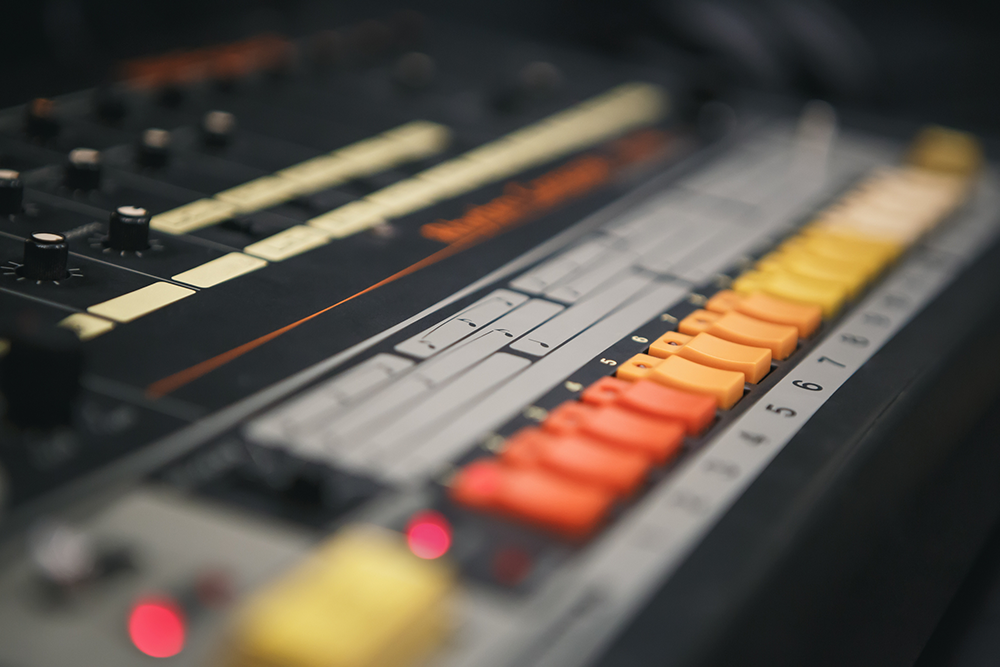By Keith Walsh
Not too long ago in this age of catchphrases and memes, some clever soul in the electronic music industry designated August as “808 Day,” to honor the groundbreaking drum machine, The TR-808 from Roland.
Japan’s Roland Corporation considered the TR-808 a commercial failure after its launch in 1980. By 1982 the production run had ended, with only 12,000 units manufactured. Yet like the Van Gogh of analog drum machines, the TR-808 has only grown in reputation and popularity after its demise.
The reasons for this are many. First, it was a robust device, made of sturdy metal, with practical hardware knobs and buttons that made it easy to program patterns and combine them into songs. It was pretty much the first of its kind in terms of memory and functionality, and was an affordable choice for those considering the Linn LM-1. The LM-1 featured digital samples of acoustic drums, which sounded a lot like their audio sources, while the TR-808’s sounds were entirely analog, with a very distinctive character derived from subtractive synthesis. Unlike earlier Roland drum machines, the features on the TR-808 made it more than suitable for applications outside of lounge or novelty acts. Depeche Mode, Marvin Gaye and Hall & Oates were just a few of the artists who used the TR-808 early on.
The sounds? They were similar to those found on earlier Roland drum machines, though juiced up, with a snappy analog snare, a kick drum that could be beefy or fey depending on tone and pitch settings, some sweet hi hats and a crash cymbal that pretty much could be used only ironically or heavily processed. The maraca and cowbell were pretty useful too, when used tastefully. There were some adequate toms and a clave, and the iconic handclap that’s still used in various sampled forms in rap and hip hop today.
Fortunately, heavy processing was completely practical, as the TR-808 had separate outputs dedicated for each of its 16 instrument sounds. There were no onboard effects, so any reverb, delay, chorus – you name it – could be added on the way out. This was an improvement on other drum machines then and now that feature only stereo outs of the sum of all sounds. It’s this flexibility that I suspect made the TR-808 so popular in the years of its release and especially in a variety of genres and styles across the four decades since that time. The list of artists who have used the TR-808 reads like a who’s who in electronic music and music making in general. The names are simply too humorous to mention, and too conveniently, Wikipedia has the most complete (though not exhaustive) info I could find: Roland TR-808 On Wikipedia.
Techno Pop
My band Fahrenheit, which lasted only a couple years from 1981 to 1983, was an early adopter of the TR-808. And though the cool harvest-colored silkscreen on the TR-808 is emblazoned with the words “Rhythm Composer” in a futuristic font on its face, Fahrenheit’s frontman John Crawford called the machine a “Compu-Rhythm” on the rare occasions that he introduced the band to the crowd. “Compu-Rhythm” may be a catchy phrase, but that was actually the moniker of the 808’s predecessor, Roland’s CR-78.
In recent years, a spate of imitations and emulations of the TR-808 have hit the market, from companies like Behringer and Arturia, and updated variations from Roland itself. That’s not including the myriad of samples and other uses inside of DAWs (Digital Audio Workstations.)
John Crawford’s dot com features a few tracks from the recording sessions of Fahrenheit’s aborted debut album. I understand that these songs were rescued in the early 2000s from an ancient cassette tape that Berlin’s David Diamond had laying around — which somehow serves as an apt metaphor for the entirety of my career in the music industry.
I’m not sure how I’ll be celebrating 808 Day On 2023. But chances are that when I turn on the radio or listen to music on a streaming service, sounds derived from or inspired by the Roland TR-808 will bounce across my environ – pretty much like any other day.
(Close up photo of TR-808 licensed from Adobe Stock, from Hurricanehank)
Roland TR-808 History On Roland.com
Roland Drum Machine Chronicle
Wikipedia List Of TR-808 Artists
Attack Of The 808 Clones
Fahrenheit On John Crawford Music dot com
finis
